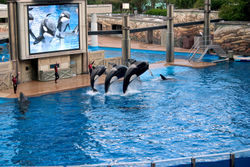Fish Guide
Dolphinarium
|
From Wikipedia the free encyclopedia, by MultiMedia |

A dolphinarium is an aquarium for dolphins. The dolphins are usually kept in a large pool, though occasionally they may be kept in pens in the open sea, either for research or for public performances. Some dolphinariums consist of one pool where dolphins perform for the public, others have expanded into much larger parks, keeping other marine animals and having other attractions. These larger parks are often not considered to be dolphinariums themselves, but marine mammal parks or theme parks that include a dolphinarium. A dolphinarium can also be part of a zoo.
Contents |
History

Though cetaceans have been held in captivity in both North America and Europe since the 1860's, the first being a pair of Beluga Whales in the New York museum, dolphins were first kept for paid entertainment in the Marine Studios dolphinarium founded in 1938 in St. Augustine, Florida. It was here that it was discovered that dolphins could be trained to perform tricks. Recognizing the success of Marine Studios, more dolphinariums keeping dolphins for entertainment followed.[1] In the 1960's, keeping dolphins in captivity for entertainment purposes became increased in popularity after the 1963 Flipper movie and subsequent Flipper television series. In 1966, the first dolphin was exported to Europe. In these early days, dolphinariums could grow quickly due to a lack of legislation and lack of concern for animal welfare. New legislation, most notably the 1972 Marine Mammal Protection Act in the United States, combined with a more critical view on animal welfare forced many dolphinariums around the world to close. As an example, during the early 1970's there were at least 36 dolphinariums and travelling dolphin shows in the United Kingdom, none of which still exist today, the last dolphinarium in the UK having closed its doors in 1993.[2]
Design

A common dolphinarium design for public performances consists of stands for the public around a semi-circular pool, sometimes with glass walls which allow underwater viewing, and a platform in the middle from which the trainers direct and present the show.
The water in the pools has to be constantly filtered to keep it clean for the spectators and the dolphins, and the temperature and composition of the water has to be controlled to match the conditions dolphins experience in the wild. To give an indication of pool sizes, the European Association for Aquatic Mammals recommends that a pool for five dolphins should have a surface area of 275 m² (2960 ft²) plus an additional 75 m² (810 ft²) for every additional animal, have a depth of 3.5 m (11.5 ft) for at least the minimum surface area and have a water volume of at least 1000 m³ (35300 ft³) with an additional 200 m³ (7060 ft³) for every additional animal. If two of these three conditions are met and the third is not more than 10% below standard, the EAAM considers the pool size to be acceptable.[3]
Species
Various species of dolphins are kept in captivity and also several other small whale species such as Harbour Porpoises and Belugas, though in those cases the word dolphinarium may not be fitting as these are not true dolphins. Bottlenose Dolphins are the most common species of dolphin kept in dolphinariums: they are relatively easy to train, have a long lifespan in captivity and a friendly appearance. Hundreds if not thousands of Bottlenose Dolphins live in captivity across the world, though exact numbers are hard to give. Orcas are well known for their performances in shows, but the number of Orcas kept in captivity is very small especially when compared to the number of bottlenose dolphins, with only 46 captive Orcas being known as of 2006.[4] Of all Orcas kept in captivity, the majority are located in one of the SeaWorld parks in the United States. Some other species kept in captivity are Spotted Dolphins, False Killer Whales and Common Dolphins, but all in much lower numbers than the Bottlenose Dolphin. Two unusual and very rare hybrid dolphins known as Wolphins are kept at the Sea Life Park in Hawaii, which are a cross between a Bottlenose Dolphin and a False Killer Whale.
Trade and capture

In the early days, most Bottlenose Dolphins were wild caught off the coast of Florida where they are common, but the 1972 Marine Mammal Protection Act put an end to this. In most Western countries, few new dolphins are wild caught and breeding programmes have been set up to provide the dolphinariums with new animals. To achieve a sufficient birth rate and to prevent inbreeding, artificial insemination (AI) is occasionally used. The use of AI also allows dolphinariums to increase the genetic diversity of their population without having to bring in any dolphins from other locations, which is a complex operation and very stressful for the animal.
Live dolphins are still traded however. A live Bottlenose Dolphin is estimated to cost between a few thousand and several tens of thousands of US dollars, depending on age, condition and prior training. The trade of dolphins is regulated by CITES. Cuba is a major exporter of dolphins, this being organised by the Acuario Nacional de Cuba.[5] In recent years, the Solomon Islands have also allowed the capture and export of wild dolphins for the entertainment industry[6], however a 2005 law has now banned the export of dolphins.[7] Some, mainly Japanese, dolphinariums obtain their dolphins from local drive hunts.
Animal welfare

Though animal welfare has improved significantly over the last few decades, many animal rights and welfare groups such as the WSPA still consider keeping dolphins at dolphinariums a form of animal abuse. The main arguments are that dolphins do not have enough freedom of movement in pools regardless of pool size and do not get enough stimulation. Dolphins often show repetitive behavior in captivity and sometimes become aggressive towards other animals or people, having resulted in a number of fatalities amongst animals and also people, with at least one trainer having been killed. In some cases, the behaviour of dolphins in captivity also results in their own death.[8]
The lifespan of dolphins in captivity is an other subject of debate and research has shown that Orcas indeed have a much lower survival rate in captivity, however, for Bottlenose Dolphins no significant difference between survival rates can be found.[9]
In response to criticism, dolphinariums often stress that every effort is being made to ensure the well being of the animals.[10] Many dolphinariums are also involved in research projects, help out in case of beachings, provide aid to sick or injured wild animals and have educational programmes. Dolphin-assisted therapy (DAT), also known as dolphin human therapy (DHT), which is offered at many dolphinariums world wide, is considered to benefit people, especially children, with various psychological and neurological problems such as autism, depression, Down syndrome and various development problems.[11]
See also
References
- Iridescent-publishing.com - The rose-tinted menagery, a history of keeping animals for entertainment, chapters four to six.
- ^ "Following P.T. Barnum's ill-fated display of white whales in his New York Museum in 1860, it was not until 1913 that cetaceans were again seen in captivity, this time when C. H. Townsend, curator of the New York Aquarium, stumbled upon the idea exhibiting dolphins as an unbeatable novelty to attract the crowds.", "During feeding time at Marine Studios, it is said, dolphins gradually fell into the habit of jumping up to catch the fish that were thrown to them, and this miniature spectacle always amused the public, the keepers and curator. Then a year later in 1939, Cecil M. Walker, then responsible for maintenance of the water purification pumps on the night-shift, observed one evening how a dolphin pushed a pelican feather across the surface of the water towards him. "Just for the hell of it" he took the proffered feather and threw it back into the water, whereupon, to his great surprise, the dolphin brought it back again. The game continued with Walker experimenting with a ball, an inner tube of a bicycle, small stones and other objects. As the game took shape with other dolphins joining in the act, it began to resemble the repertoire seen today in every dolphinarium in the world.", quotes from The rose-tinted menagery.
- ^ "In the golden heyday of the industry, there were at least 36 assorted dolphinaria or itinerant dolphin shows in the U.K.", quote from The rose-tinted menagery
- ^ Recommended EAAM dolphin housing standards.
- ^ Orcas in Captivity - A look at killer whales in aquariums and parks (when viewed 10 October 2006)
- ^ "But it is in Fidel Castro's revolutionary Cuba that dolphin catching in South America has been given a new lease of life, under the auspices of the quasi state-run enterprise Acuario Nacional.", quote from The rose-tinted menagery
- ^ HONIARA, Solomon Islands (Reuters) - A cargo plane arrived in the lawless Solomon Islands Monday to pick up wild dolphins captured to order for a Mexican syndicate in what activists have blasted as an environmental crime, regional media reported. [1]
- ^ Solomon Islands law banning the export of dolphins
- ^ Dolphin aggresion in captivity, listing a large number of incidents in dolphinariums that resulted in injury to either dolphins or trainers, including self-inflicted trauma. There is mention of one fatal incident involving a trainer.
- ^ Survival rate study of marine mammals in captivity
- ^ "The biologists of Xcaret Park and veterinarians meet all the needs of these amazing dolphins. They monitor their health, weight, food, and in some facilities they conduct research on their behavior to present their findings at international conferences. Here, dolphins are treated with care and respect; their well being is always the main priority. In fact, biologists claim that the life expectancy of a dolphin, which is about 40 years, increases when they are placed in captivity or semi-captivity (in extensive areas of their natural habitat). As proof of this, dolphins have actually been born in one of these aquariums.", quote from: [2]
- ^ "Animal facilitated therapy with dolphins is more effective than "water" therapy in treating people with mild to moderate depression after the influence of the natural setting has been controlled for, as shown by our randomised, single blind, controlled trial. The animal care programme improved the depressive symptoms of the participants significantly more than the outdoor nature programme. The natural setting itself is also an important factor that has to be considered in the treatment of emotional disorders. This is confirmed by other studies. The effects exerted by the animals were significantly greater than those of just the natural setting.", quote from Randomised controlled trial of animal facilitated therapy with dolphins in the treatment of depression, a paper by Christian Antonioli, PhD candidate in psychiatry and Michael A Reveley, professor of psychiatry.
External links
- Alliance of Marine Mammal Parks and Aquariums
- Dolphin Human Therapy Inc. - website of a DHT company detailing the method
- Marine Attractions - Below the surface - several articles by the Sun Sentinel on marine mammals in captivity, mainly in the United States. Includes photos and videos.
- Tursiops.org - news on dolphins and other whales in captivity.
Fish Guide, made by MultiMedia | Free content and software
This guide is licensed under the GNU Free Documentation License. It uses material from the Wikipedia.